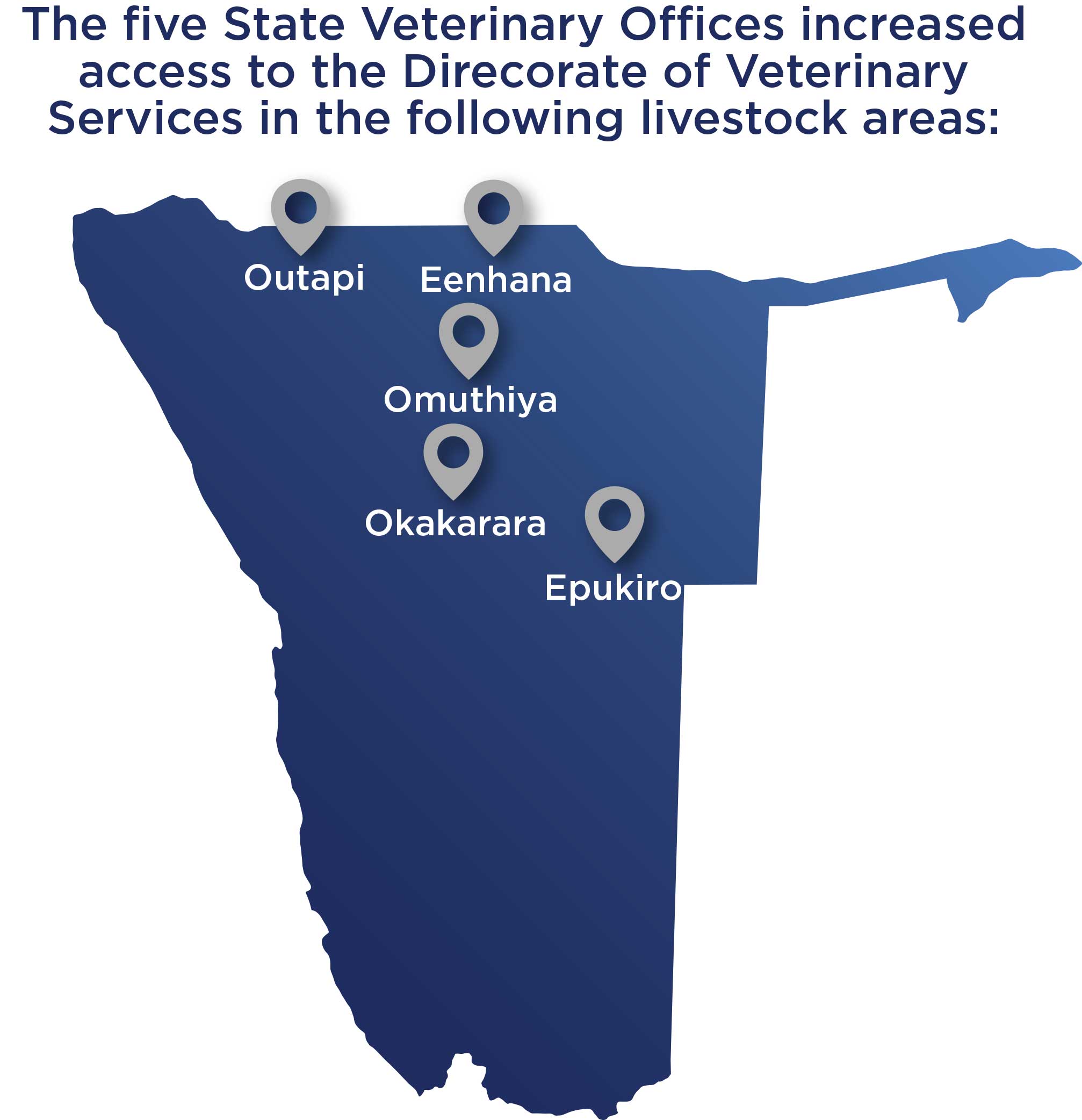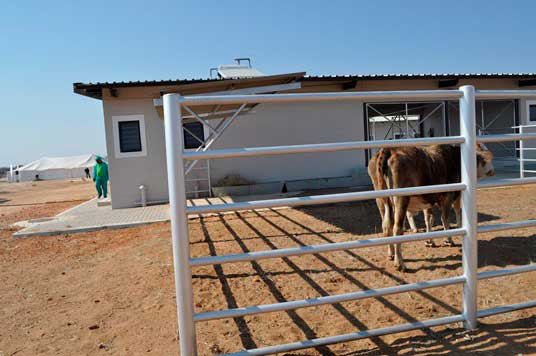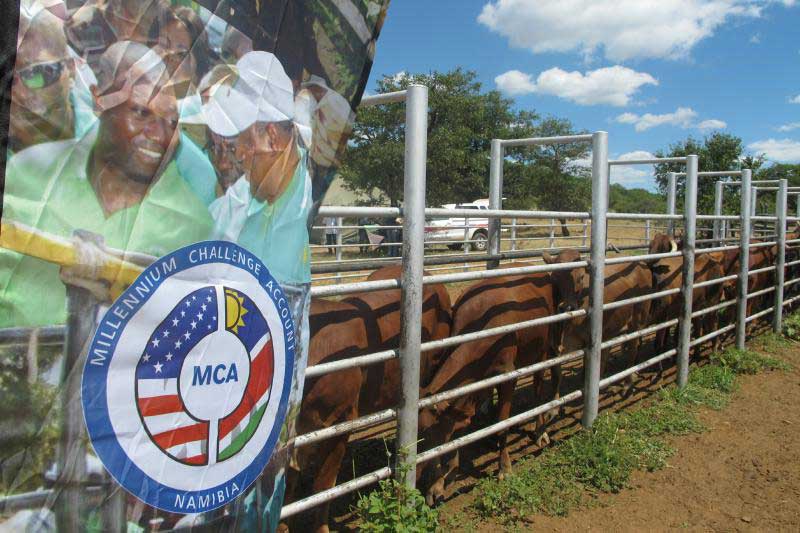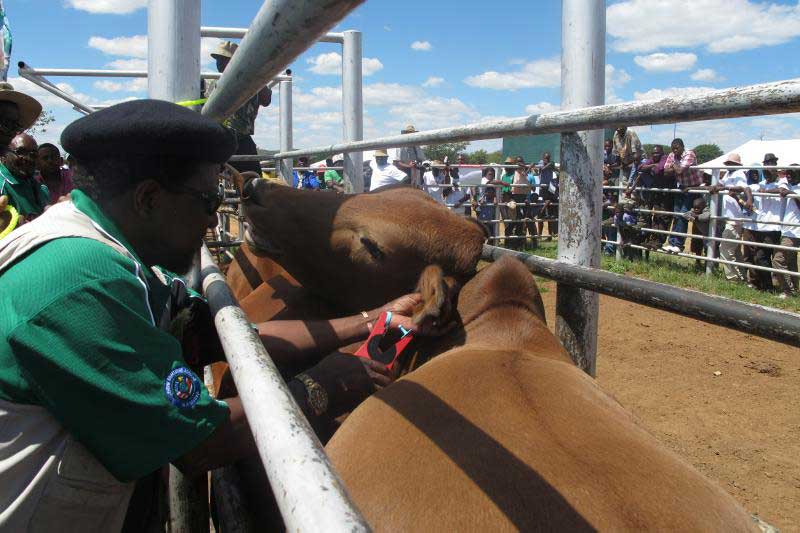Program Overview
MCC’s $295.7 million Namibia Compact (2009-2014) funded the $20.6 million Livestock Support Activity. The activity aimed to increase livestock productivity and profitability by improving livestock management and increasing access to veterinary services and markets to raise farmer incomes. Sub-activities included constructing five veterinary centers, rehabilitating two livestock quarantine camps to reduce disease spread, a livestock traceability system, and eight grants under the Livestock Market Efficiency Fund.
Evaluator Description
Millennium Challenge Account Namibia commissioned Paul Sijssens to conduct an independent final performance evaluation of the Livestock Support Activity. Full report results and learning: https://data.mcc.gov/evaluations/index.php/catalog/190.
Key Findings
Livestock Health
- The construction of five State Veterinary Offices increased access to the Directorate of Veterinary Services in three high-volume and two underserved areas.
Livestock Management and Disease Control
- A livestock traceability system was established to manage and monitor livestock movement and health, with nearly two million livestock tagged during the program.
- Two livestock quarantine camps were rehabilitated to facilitate disease control.
- Grants supported community-level training, though participation and completion were low.
Market Access, Sales, and Profitability
- Grants supported marketing and trade studies; one had methodological limitations and another recommended protocols that were not adopted by program end.
- The evaluation did not measure outcomes such as international market access, market sales, or profitability due to an original unclear project logic.
Sustainability
- The Compact funded veterinary centers and traceability system were integrated into the existing Ministry of Agriculture, Water, and Forestry systems.
- The two livestock quarantine camps’ sustainability was considered low given a history of deferred maintenance and the ongoing lack of an operations and maintenance plan.
Evaluation Questions
This final performance evaluation was designed to consider the activity’s relevance, effectiveness, efficiency, impact, and sustainability to determine if the activity:
- 1
Improved livestock health? - 2
Improved livestock management and disease control? - 3
Increased market access, sales, and profitability? - 4
Demonstrated sustainability?
Detailed Findings
Livestock Health

Almost 65 percent of activity costs were invested in constructing five State Veterinary Offices, which increased access to the Directorate of Veterinary Services in three high-volume northern livestock areas (Eenhana, Outapi and Omuthiya), and two underserved livestock areas (Okakarara and Epukiro). In the Northern Communal Areas, grants also supported livestock health and soil studies, which produced findings that could inform future disease control and management actions.
Livestock Management and Disease Control

Handheld computer used for livestock traceability system.
A livestock traceability system was established to manage movement and monitor health status of livestock. Nearly two million cattle were tagged and registered in the system, which the evaluation considered essential for disease control. Two livestock quarantine camps were rehabilitated to facilitate disease control. In Oshana and Ohangwena regions, a grant supported farmer training on livestock management and established Community Animal Health Agents in 12 villages. More than 1,000 farmers participated initially; however, few farmers completed the full training. Another grant focused on establishing a roadmap to eradicate Foot and Mouth Disease and Contagious Bovine Pleuropneumonia; however, the strategy report was delayed and not reviewed or approved by the World Organization for Animal Health nor adopted or funded by the Namibian government by program end. In the Zambezi Region, one grant tested use of food safety and animal disease risk management protocols to demonstrate beef products were safe to consume and to develop export opportunities. By applying the protocols, the study showed that beef from the Zambezi region was safe; however, the Namibian government and international markets were not convinced by program end.
Market Access, Sales, and Profitability
The evaluation noted possible increased throughput capacity—the number of cattle that can pass through the system in a specific amount of time—at the quarantine camps. However, the evaluation did not measure market access, sales, or profitability outcomes across the interventions due to an unclear project logic.
Sustainability

Newly constructed Epukiro Veterinary Center.
The evaluation reported the traceability system had a high probability of sustainability because it was integrated into existing government systems and therefore could potentially have a high impact, though it was too early to assess actual impact on disease control. The evaluation also noted the government would have to budget to continue operating and updating the system. The evaluation questioned whether routine maintenance would take place for the quarantine camps and State Veterinary Offices and noted that sustainability was uncertain for the grant programs that trained local communities. Furthermore, impact and sustainability of nearly all the grant-funded studies were noted to depend on additional government actions and funds, which were not yet secure.
MCC Learning
Understand and document the project logic prior to project approval and evaluation planning. MCC’s compact development and evaluation management guidelines now ensure that all projects have a clearly defined project logic that guides project implementation and evaluation objectives.
Broad consultation and sustainability mechanisms need to be incorporated into project design from the beginning. For interventions that are expected to benefit the private sector, MCAs and MCC might also seek private sector co-financing to increase their vested interest in sustainability.
MCC-funded evaluations need to follow MCC’s evaluation standards. MCC’s Evaluation Management Guidance was developed after this evaluation started. The Guidance is aimed at ensuring MCC-funded evaluations are worth their costs and include several safeguards to prevent the kinds of issues encountered here—such as ensuring project logic informs evaluation questions and outcomes measured — or resolve them early if they do arise.
Evaluation Methods
The activities were implemented from 2011 until the program end, with some activities still not completed as of program end, leading to an exposure period of 0-42 months.

Preparing cattle for tagging for livestock traceability system.
A key point made by the independent evaluator to consider is that the activity’s logical framework was constructed after the sub-activities were approved and under implementation. Given the evaluator was hired midway through implementation, the original lack of a coherent project logic and definition of expected results constrained the evaluation methodology. As a result, the evaluation was not designed to directly measure outcomes or benefit streams modeled in the economic analysis of the program, including average price, total production, and income from cattle.
The performance evaluation applied a methodology called Real Time Evaluation, which involved an iterative process of conducting nine missions, as well as following, assessing, and documenting implementation progress based on document review and triangulation with field observations and interviews from February 2012 to July 2014. Rather than focus directly on the evaluation questions outlined originally, the evaluation used the Development Assistance Criteria defined by the Organization for Economic Cooperation and Development, which assesses the success of a program using five criteria: relevance, effectiveness, efficiency, impact, and sustainability. Primary data were not collected for this evaluation.
2020-002-2433


